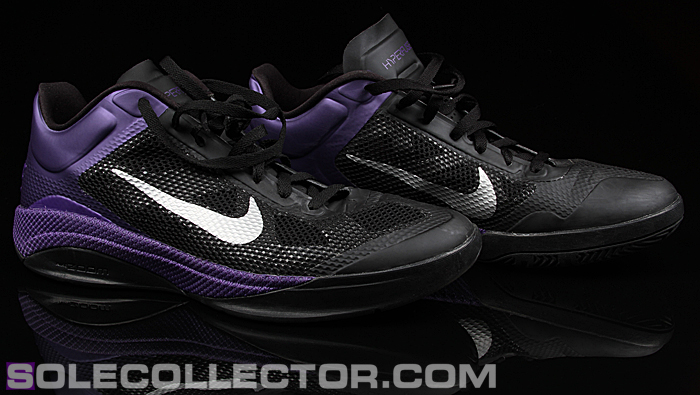
Hyperfuse Low Performance Review | A Great Alternative to Great
words & images // Nick DePaula
By all accounts, whether it was the feedback of casual hoopers, messageboard junkies, NBA pros or everyone in between, Nike Basketball’s Zoom Hyperfuse was a great shoe. Great for all sizes, great for all styles of play, and even better, it offered up -bilities, which you always want, of course. There was a newfound breathability and durability to it, and I’ve even heard the not-real term “comfortability” used to describe the joy that it was to play in the Hyperfuse. At just $100, the construction was new and different, and the general comfort, weight, fit, playability and longevity of the Hyperfuse were all, well…great
If the Hyperfuse Low is just a drop-top version of it’s mid-cut neighbor, then it should be great too, right? Good news: It was awesome to play in throughout my more than 3-week wearing. The Low even offers up all of the same bells and whistles as the Hyperfuse Mid, a bit more range of motion, and, quite obviously, even less weight.
 The reason the Hyperfuse Low translates so well from just a few notches taller in height is the fact that Nike Basketball Design Director Leo Chang and Footwear Developer Dolores Thompson didn’t just simply chop the top, as most brands did up until around five years ago. As Chang has mentioned many times, people are seriously playing in Lows these days, and the Nike Basketball team has to do their due diligence in building out great midfoot and heel fit in their shorter shoes. There’s a system in place, and by carefully measuring the slopes and contours of the collar — now as a low — the shoe still ensures the same great heel fit that I enjoyed in the original Hyperfuse. While the sheer mention of “Low” struck fear in hoopers around the world just a few years ago, as we’ve learned since the launch of the Zoom Kobe IV, the security and assurance found in the right marriage of heel fit, midfoot lockdown and a stable base can team up to provide for some damn good ankle support. Yes, even if that means the collar height you’re used to is nowhere to be seen.
The reason the Hyperfuse Low translates so well from just a few notches taller in height is the fact that Nike Basketball Design Director Leo Chang and Footwear Developer Dolores Thompson didn’t just simply chop the top, as most brands did up until around five years ago. As Chang has mentioned many times, people are seriously playing in Lows these days, and the Nike Basketball team has to do their due diligence in building out great midfoot and heel fit in their shorter shoes. There’s a system in place, and by carefully measuring the slopes and contours of the collar — now as a low — the shoe still ensures the same great heel fit that I enjoyed in the original Hyperfuse. While the sheer mention of “Low” struck fear in hoopers around the world just a few years ago, as we’ve learned since the launch of the Zoom Kobe IV, the security and assurance found in the right marriage of heel fit, midfoot lockdown and a stable base can team up to provide for some damn good ankle support. Yes, even if that means the collar height you’re used to is nowhere to be seen.
Not only did the height get knocked down, but the price was also knocked down $10 at retail. The only noticeable difference between Low and Mid is the original’s added height and collar foam package, but that’s really where the differences end. Unlike past low-top versions of awesome performing shoes, like the Zoom BB for example, the Hyperfuse Low still includes the same cushioning platform as the original version. In other models, the removal of Zoom Air for the Low has been a disappointment, but here, you’re treated to the same exact full-length Cushlon midsole and 6 mm forefoot Zoom Air unit.
The Low also features the same exact highly segmented outsole, and even though it’s mostly all solid rubber, there’s a great amount of flexibility and court feel that makes the shoe well suited for point guards and active players alike. The heel-to-toe transition is seriously smooth, and if that ranks highly on your list of priorities (like it does for me), then you’ll love the Hyperfuse low. The shoe’s perfectly radiused heel and dual lateral outriggers roll over smoothly through your stride, and coupled with the shoe’s tremendous fit through the collar and midfoot, it’s one of those shoes that you entirely forget about while you’re playing. Which is ideal.
Aside from the noticeable — like the collar height — there really aren’t too many differences otherwise between the Hyperfuse Mid and Low. The Low still features the same biting full-length herringbone traction pattern for great grip, even on my suspect 24 Hour Fitness courts, and there’s still the same amount of reliable support in the upper pattern that was found in the first. The weight is of course a bit better in the Low, but both shoes are proudly apart of the featherweight class anyways, so you’re fine in either version.

The only thing holding me back from giving the Hyperfuse Low a solid A grade is the fact that the cushioning could be a bit better, as the heel leaves a bit to be desired once you get a few weeks into the shoe and the foam compound starts to give a little, and the forefoot Zoom Air unit isn’t as responsive as other similar applications, like the Zoom KD III for example. It could be worse — the second thing to go in Lows, after the height, is usually Zoom Air, but I’d still like a bit more responsiveness under the ball of my foot here. That’s really my only actual complaint. The traction is tremendous. The upper is so thin and flexible — yet still supportive — that you’re able to great perfect lockdown and fit through the midfoot with the conforming and pliable mesh and synthetic composite practically forming to your foot. I’d have a hard time trying to find a better fitting shoe than the Hyperfuse this season, and the Low is even better.
 If you’re a guard after great traction, transition and lockdown, the Hyperfuse Low is for you. If you’re a slashing player that’s neither all that explosive nor excessively quick (hey — that‘s me!), but you like great fit, heel-to-toe smoothness, light weight and sweet court feel, then the Hyperfuse Low is a great option too. If you’re a post, require heel impact protection or have fairly wide feet, these might not be ideal for you. Much like the Hyperfuse Mid, it’s worth pointing out that the one downside of the shoe’s awesome midfoot lockdown and heel fit is a bit of a narrow fit for some. If you’re in between sizes, you might want to go up a ½ size. Everything about it is smooth and flexible when moving ahead, and the Hyperfuse Low also does a great job of being supportive and reliable when you need it laterally. At just $90, the Hyperfuse Low is among a rare esteemed batch of shoes that you can gladly forget about while you’re playing — always a great pleasure to find.
If you’re a guard after great traction, transition and lockdown, the Hyperfuse Low is for you. If you’re a slashing player that’s neither all that explosive nor excessively quick (hey — that‘s me!), but you like great fit, heel-to-toe smoothness, light weight and sweet court feel, then the Hyperfuse Low is a great option too. If you’re a post, require heel impact protection or have fairly wide feet, these might not be ideal for you. Much like the Hyperfuse Mid, it’s worth pointing out that the one downside of the shoe’s awesome midfoot lockdown and heel fit is a bit of a narrow fit for some. If you’re in between sizes, you might want to go up a ½ size. Everything about it is smooth and flexible when moving ahead, and the Hyperfuse Low also does a great job of being supportive and reliable when you need it laterally. At just $90, the Hyperfuse Low is among a rare esteemed batch of shoes that you can gladly forget about while you’re playing — always a great pleasure to find.
KEY DETAILS & BUYING ADVICE:
Designer: Leo Chang
Release: Spring 2011
Colorway tested: Black/ Varsity Purple
Best For: Guards and swift Forwards
Key Tech: Hyperfuse upper construction, full-length herringbone pattern outrigger, heel and forefoot lateral outrigger, zonal padded tongue, TPU midfoot shank
Pros: Outstanding traction, fit and lockdown, heel-to-toe transition, support, breathability and weight. The Hyperfuse Low has a ton of great features going for it, and is well-priced at $90.
Cons: The overall cushioning could be better, as the heel foam will break down over time, and the forefoot Zoom Air unit leaves a bit to be desired in terms of responsiveness.
Improvements: Improve overall cushioning, as foam-based platform breaks down over time.
Buying Advice: The Hyperfuse Low is a must for guards who like great traction, transition, and court feel, and it also offers up outstanding lockdown and support for any movements. Weighing just 12.4 ounces and priced at $90, it combines all of the best features of the first Hyperfuse, but is both lighter and $10 cheaper. Forget it if you need great heel cushioning or have overly wide feet.
Available now: Nike Zoom Hyperfuse Low



